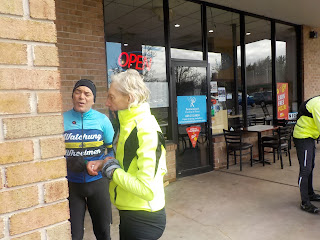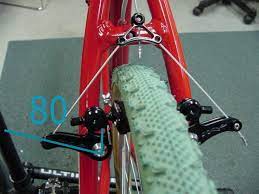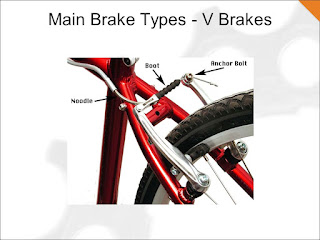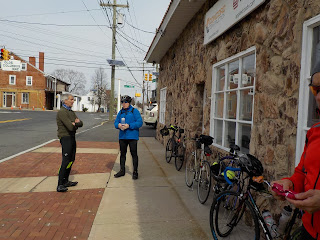This is an unnecessarily long rant that will be of little interest to most folks, although there are a few mild jokes along the way. Feel free to skip this; it won't be on the final.
While I hear that off-road and gravel riders are at least as likely these days to go with flat pedals (possibly with pins to hold their shoes on the pedals) as to get so-called "clipless" pedals, with a cleat that holds the shoe to the pedal, most road riders of my acquaintance seem to prefer riding clipped-in.
These systems are called "clipless" because they replace the toe clips that were affixed to flat pedals.
The theory is that, with one foot still on the ground, you slide the toe into the clip, and pull the strap tight with your hand, then repeat with the other foot... but at that point, you haven't got a foot to put on the ground to steady yourself. Also, it can be treacherous to get out of these if you've been less than perfect with the strap adjustment. This system was followed by the "clipless" pedal system, for which the shoe is attached to the pedal by some means other than the toe clip (usually be a cleat attached to the bottom of the shoe that snaps into a mechanism on the pedal). Release is usually by turning the heel out or in.
While Cinelli claims to have invented the clipless pedal in the 70's, the common wisdom is that the system was developed by Look, at the time a manufacturer of ski bindings (and so with experience in releasable-shoe-to-object attachment systems), in the mid-80's. Other manufacturers, like Time, Shimano, Campagnolo, and others, developed competing systems. They were (and are) used by racers and by road riders. The cleat is attached to the sole of the shoe, and forces the toe upward when walking.
Shimano states they developed a system for off-road riders, their SPD system, in 1990. This system was more robust than most of the road systems, and designed so that mud would not interfere with the clipping-in and -out process. The associated shoes usually have insets for the cleats, and walking is easier in these shoes.

Others' experience may be different, but my memory indicates that road riders tend to start with a clipless system and stick with it, partly because pedals are expensive (cleats less so, although they can add up), and partly because, aside from the annoyance of learning to clip in and out of a new system, the pedal style doesn't matter much to the ride or your speed (although I understand triathlon competitors have favorites, and leave the shoes clipped into the bike to save seconds when switching to the cycling part of the event). I started with a Look Delta system, and changed to Look Keo when it came out (from worry that the Delta cleats would be discontinued [the plastic road cleats wear out and need to be replaced, as the metal SPD cleats do not], a fear which has not been realized [unlike my fear that my favorite saddle would be discontinued... it was, and I have yet to forgive Specialized Bicycles. I'm sure they are sleepless with regret]). I continued with the Keo's for years.
Until now.
A few years ago, Look started to make alternative cleats, with rubber inserts to allow more traction when walking (the plastic cleats can be tricky when walking on linoleum-like floors). Off-brand manufacturers have largely followed suit, probably because the price of the cleats with the new feature is higher than the price of the cleats without the inserts.
But the rubber wears quickly. This changes the shape of the cleat, and, I find, makes it harder to "clip in". One can replace the cleat, but this has reduced the effective life of the plastic cleat.
OK, so just buy the older, rubber-less cleats, right? Easier said than done. Cleats were one of the few things I used to buy at local bike shops*, and, in dropping in at a few, I found that the only Keo cleats available had the rubber inserts. (This makes retail sense: shelf space is a cost, and a higher-priced option offers a better return on the use of the space.)
*Cyclists are often reminded by our associates to buy at local bike shops, to ensure that they stay in business and are available when we need service and repair. There is now a shop in Highland Park, NJ, yclept "Local Bicycle Shop". I see what you did there. (Check out the web address.)
One can get the original cleats online, but enough, already. I have a pair of shoes with SPD cleats attached, and I can get a pair of SPD pedals for only a little more than the cost of the replacement cleats. (On some bike-related items, I am incredibly cheap. I buy good tools, but for most other bike items, if there's a less expensive way to do it, I probably know it.)
Many club members already use the SPD system, initially intended for off-road, on their road bikes. They like the durability of the system, and the fact that one can walk (and even drive safely) in the shoes with the SPD cleats attached. I used to use my SPD system on winter rides (because those shoes are a bit more weather-resistant), but I installed the pedals on The Excellent Wife (TEW)'s bike some time ago and so gave up the practice of changing systems for winter. But I used the SPD system on yesterday's ride, and I think I'm persuaded. I've still got the Keo stuff in the drawer, but I expect it will stay there.


























































